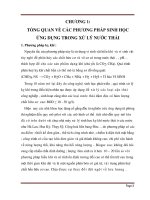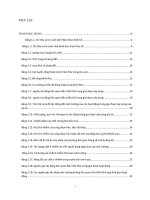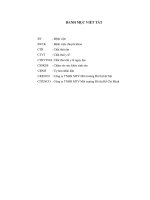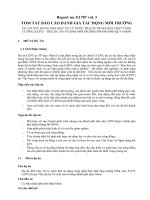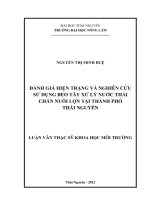Đánh giá nhu cầu oxy sinh hóa và cặn lắng sơ cấp, sục khí và làm sạch trong ở nhà máy xử lý nước thải cảu Viện Phát triển thành phố Yangon_Myanmar
Bạn đang xem bản rút gọn của tài liệu. Xem và tải ngay bản đầy đủ của tài liệu tại đây (1.49 MB, 30 trang )
Evaluation on Biochemical Oxygen Demand and Solids of
Primary Sedimentation, Aeration and Final Clarifier in
Wastewater Treatment Plant of
Yangon City Development Committee
Min Thu Naung
MBBS MMedSc (Public Health)
ID-290
INTRODUCTION
Background Information
• Yangon is the largest city and is highly
urbanized.
• Since 1888 the wastewater discharged from
six downtown townships of Yangon were
discharged by conventional disposal system
directly into Yangon River.
Justification
• WWTP is located in Botahtaung Township.
• It was opened on December, 2006.
• It treats the wastewater discharged from six downtown townships
of Yangon city and disposes the effluent into the Yangon River. The
treatment plant has the capacity of 3.25 million gallons per day
(MGD). It is now treating about 500,000 gallon of wastewater per
day. The two main pipe lines were used for conveying wastewater
from these six townships. Wastewater is treated by the processes;
preliminary treatment stage, primary treatment stage, biological
treatment stage and sludge treatment stage and then the effluent
is discharged into the Yangon River.
Justification (Cont:)
• In the WWTP, temperature and pH of wastewater are monitoring
routinely.
• But biochemical oxygen demand (BOD) and solid matters are not
measured in this treatment plant. Biochemical oxygen demand
and solid matters are important parameters in wastewater
treatment.
• This study aims to assess the biochemical oxygen demand and
solids of the effluent in the WWTP.
• The result of this study is intended to evaluate the effectiveness of
the WWTP.
Existing Sewerage System in Yangon City
Sanitation and sewerage for the Yangon City area is main
responsibility of Engineering Department (Water and
Sanitation) under Yangon City Development
Committee.
Existing system, conventional sewerage, consists of:
(1) Gravity sewers
(2) Thirty nine pneumatic ejector stations
(3) Air distribution main
(4) Two sewage force mains and outlet
Treatment Processes in Wastewater
Treatment Plant of YCDC
Treatment process is called activated sludge process.
The treatment process can be divided into four stages.
They are;
(1) Preliminary Treatment Stage
(2) Primary Treatment Stage
(3) Biological Treatment Stage
(4) Sludge Treatment Stage.
Preliminary Treatment Stage
Auto bar screen, pump sump and grit chamber are
included.
Primary Treatment Stage
Primary sedimentation tank is used for the solid separation.
Biological Treatment Stage
Aeration tanks are designed followed by the secondary
sedimentation tanks.
Sludge Treatment Stage
Sludge thickener tank and sludge digester tank are included.
OBJECTIVES
General Objective
To evaluate the biochemical oxygen demand and
solids of wastewater influent, effluent of
primary sedimentation, effluent of aeration
and effluent of final clarifier in Wastewater
Treatment Plant of Yangon City Development
Committee
Specific Objectives
(1) To assess the biochemical oxygen demand and solids of wastewater
influent in Wastewater Treatment Plant
(2) To assess the biochemical oxygen demand and solids of the effluent of
primary sedimentation in Wastewater Treatment Plant
(3) To assess the biochemical oxygen demand and solids of the effluent of
aeration in Wastewater Treatment Plant
(4) To assess the biochemical oxygen demand and solids of the effluent of
final clarifier in Wastewater Treatment Plant
(5) To compare the qualities of wastewater influent and effluent of
Wastewater Treatment Plant
RESEARCH METHODOLOGY
Study Design
Cross-sectional descriptive study
Study Population
Wastewater samples from Wastewater Treatment Plant of YCDC
Study Area
Wastewater Treatment Plant of YCDC
Study Period
From 2nd week of July to 2nd week of October, 2009
Sample Size
Wastewater samples were taken once a week for 4 weeks.
Sampling Method and Procedure
Sample taking points
point (1) the inlet of raw wastewater.
Point (2) was outlet of primary sedimentation tank.
Point (3) the outlet of aeration tanks.
Point (4) the outlet of final clarifier.
Wastewater samples were taken from the sample taking points stated as above with the
samplers, which were made up of stainless steel. They were inserted into the
wastewater at the sample taking points stated above to collect the wastewater
samples while the treatment plant was operating. 3 liters of wastewater was taken
from each point. 1 liter was for the measurement of pH and temperature, 1 liter for
biochemical oxygen demand and 1 liter for total solid, suspended solid and dissolved
solid. Then the wastewater samples were poured into the bottles which were already
cleaned and free from organic matters. The bottles were cleaned by use of a detergent
to be free of organic matter and were rinsed with hot water to kill the nitrifying
organisms. Then the wastewater samples were transported to the laboratory.
Data Analysis
Data analysis was done by the help of computer using software Minitab 14 by comparing
with the standard permissible limits.
RESULTS
Results in Day Series
Results of pH Level of Wastewater
Results of Temperature (C) of Wastewater
Results of BOD (mg/l) of Wastewater

